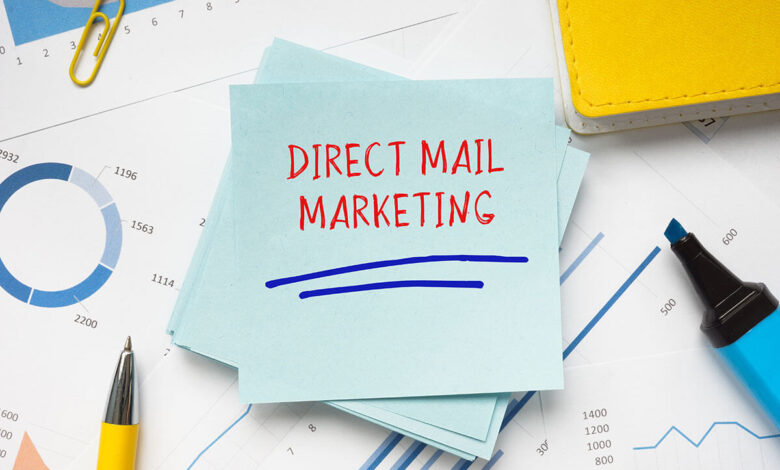How to Develop an Effective Direct Mail Marketing Strategy

In the digital age, it’s easy to overlook the power of traditional marketing strategies. But if you’re looking to cut through the noise and make a lasting impression, direct mail marketing might just be your secret weapon.
This comprehensive guide will delve into the ins and outs of direct mail marketing, from understanding its unique role in today’s marketing landscape to crafting successful campaigns that drive impressive response rates. We’ll explore the benefits of this tactile marketing approach, share tips for optimizing your campaigns, and even look ahead to the future of direct mail.
Whether you’re a small business owner or a seasoned marketer, you’ll find valuable insights to help you leverage direct mail for maximum impact. So, are you ready to take your marketing efforts to the next level?
Let’s dive in!
Understanding Direct Mail Marketing
In the realm of marketing, direct mail marketing holds a unique position. It’s a traditional marketing method that has evolved and adapted to the digital age, proving its resilience and effectiveness. This marketing strategy involves the use of physical mail to reach out to a targeted audience, offering a tangible and personal touch that digital marketing often lacks.
Direct mail marketing is not just about sending out mailers; it’s about creating a meaningful connection with the recipient. It’s a strategy that requires careful planning and execution, from the design and content of the mail to the timing of its delivery. Understanding the intricacies of direct mail marketing is crucial for any business looking to leverage this powerful tool.
Why Direct Mail Marketing Works
Despite the rapid rise of digital channels, direct mail marketing continues to hold a powerful place in the marketing sphere, and for good reason. The first notable advantage of direct mail is the tangible connection it establishes with its recipients. Unlike digital ads that often get buried under a flurry of other distractions, a direct mail piece is more likely to capture and hold an individual’s attention, increasing the chances of the recipient taking action. This physical interaction contributes to fostering a deeper emotional resonance, which is often missing in the digital brand-consumer exchange.
Moreover, direct mail marketing allows for personalized communication by leveraging comprehensive consumer data. Tailored offers that cater to the recipient’s unique interests and needs can propel direct mail marketing to outperform generic digital promotions. This kind of individualized approach enhances the relevance of the communication thereby motivating recipients to respond more positively.
The Role of Direct Mail in Today’s Marketing Landscape
In today’s digitally dominated world, direct mail’s role is evolving. As consumers grow weary of incessant digital ads, marketers are valuing direct mail as a refreshing alternative.
Standing out in a digitally congested landscape, direct mail marketing places a tangible piece of a brand directly into the hands of the consumer. This intimate interaction oftentimes leads to a more profound emotional connection, motivating recipients to take action.
In a world where marketers are in cutthroat competition for consumer attention, direct mail marketing is rising to the occasion by creating experiences that feel personal and meaningful. It’s often viewed as a high-return investment, contributing towards reaching marketing objectives. In essence, direct mail marketing is proving its mettle and reaffirming its pivotal role in today’s dynamic marketing landscape.
Key Elements of a Successful Direct Mail Marketing Campaign
Strategic Messaging: A clear, focused message is vital. Make sure it conveys your proposition and prompts a compelling call to action. Direct mail gives your brand a physical presence with the recipient, so ensure your message is concise, powerful and evokes interest.
Engaging Design: An effective direct mail campaign is not just about saying the right words, it’s about presenting those words in a visually appealing manner. High-quality graphics and innovative formats can help your mail piece catch the recipient’s eye, making your campaign more memorable.
Personalized Content: This is a powerful strategy to build a bond with the recipient. Personalize your direct mail campaign based on your customer data – address them by name, reference prior interactions or tailor offers based on their preferences – to significantly increase your campaign’s relevance and effectiveness.
Quality Material: Don’t overlook the medium; your message’s impact can be amplified by using quality materials, from the paper to envelope. It not only elevates the perceived value but also gives a tactile aspect to your marketing which can be instrumental in position your brand favorably in the minds of the recipient.
A successful direct mail marketing campaign is not just one element but a harmonious blend of multiple components. It’s a symphony where every part, from the message to the mailing list, plays its role to create an impactful performance.
Benefits of Direct Mail Marketing
In the realm of marketing, the benefits of direct mail marketing are often overlooked, yet they hold immense potential for businesses. This traditional form of marketing, when executed strategically, can yield impressive results, from increased brand visibility to higher response rates. It’s a powerful tool that can significantly enhance a company’s marketing strategy, offering a unique blend of personalization and direct audience reach.
Direct mail marketing benefits are not just limited to these. It also offers cost-effectiveness, making it a viable option for businesses of all sizes. Whether you’re a small business looking to make a mark or a large corporation aiming to maintain your market presence, direct mail marketing can be a game-changer. Let’s delve into the specifics of these benefits and understand how they can revolutionize your marketing efforts.
Increased Brand Visibility and Recognition
Direct mail marketing asserts a strong prevalence in today’s competitive marketplace, especially when it comes to elevating brand visibility and recognition. Here’s why. Unlike digital advertorials that face an increased risk of being ignored or blocked, direct mail marketing ensures that your brand physically lands in the hands of your target audience. This direct touchpoint elevates the brand’s prominence and paves the way for a memorable user experience.
Every piece of direct mail, when strategized effectively, offers multiple interactions with the recipient, leading to notable exposure crucial for brand awareness. Personalization introduces an exciting dynamic to this approach. Target audiences appreciate direct mail that reflects their preferences and habits, creating an engagement unique to them. It doesn’t merely mean adding their name – it’s about delivering a tailored experience that strengthens the recipient’s bond with the brand.
Further amplifying this impact is the integration of direct mail with digital platforms. Let’s say a direct mail piece nudges users towards a digital space; such a strategy boosts online engagement metrics and fosters significant digital connections, ensuring that your brand continues to resonate across various channels. Thus, coupling the benefits of direct mail marketing with insightful direct mail marketing plans can greatly enhance brand integrity and recognition rates.
Cost-Effectiveness of Direct Mail Marketing
Direct mail marketing is renowned for its cost-effectiveness, especially when compared to other marketing strategies. Its clever implementation allows for impressive return on investment (ROI). A well-executed direct mail marketing plan can yield a return of around $4.09 for an average investment of $1.27. In spite of the fluctuations in price—depending on variables like mailer type and the size of the mailing list—the impressive ROI underscores its position as an economically viable option.
The ongoing growth in spending on these campaigns—projected to generate roughly $13.2 billion in yearly ad revenue by 2026—also signals marketers’ faith in this tactic. This surge elucidates the power of the tactile, engaging nature of direct mail, which often delivers an impression that purely digital marketing tends to lack.
Despite the initial investment in direct mail marketing being relatively high, the potential for increased engagement and superior response rates make it a financially sound choice in the long term. Studies have shown that direct mail often garners up to a 4.4% response, starkly outperforming digital marketing methods. The high conversion rates open doors to better returns, further establishing direct mail as an effective tool in a comprehensive marketing strategy.
Targeted Audience Reach and Personalization
Understanding your target audience and tailoring your direct mail marketing to their needs is central to its success. This targeted approach not only improves your conversion rates but also boosts your return on investment. By using market segmentation to zero in on demographic details, you can cater your mail items to specific audiences, sparking greater interest and engagement.
It’s about more than just reaching a broad audience; it’s about reaching the right audience. Demographics like age, gender, and income level can play significant roles in the effectiveness of your campaign. Furthermore, geographic precision and psychographic understanding can be leveraged to even further personalize your outreach. This way, recipients will feel valued and recognized—a powerful factor in generating positive responses.
Successful direct mail marketing strategies involve a deep comprehension of the target audience’s habits and preferences. This knowledge, combined with tailored offers based on previous interactions, results in mail offers that feel exclusive and personal to the recipient. This level of personalized attention often translates into increased engagement and higher response rates – a true testament to the potential of targeted direct mail marketing.
Higher Response Rates Compared to Digital Marketing
The power of direct mail marketing is often underestimated, overshadowed by the digital era’s glistering charm. Notwithstanding, the effectiveness of direct mail in garnering higher response rates must not be overlooked. Despite the cluttered space filled with digital ads, direct mail has been reported to elicit a response rate of 2.7% to 4.4%, compelling when juxtaposed with digital marketing’s paltry 0.6%.
This marked difference arises from the tangible, personal touch that direct mail delivers. The recipient is more likely to perceive mail items physically, distinctively in a world teeming with ephemeral digital banners. Direct mail items provide a sense of authenticity, blurring the boundary between the brand and the consumer, which often lacks in a largely impersonal digital landscape.
Evidently, a well-mapled direct mail marketing plan can successfully pierce the noise that drowns digital marketing efforts. It evokes a deeper emotional connection with recipients, nudging them to act, heightening conversion rates. Thus, direct mail marketing should be an essential ingredient in your marketing mix, instrumental in creating a balanced, multi-touch communication strategy yielding amplified response rates.
Creating a Successful Direct Mail Campaign
Creating a successful direct mail campaign is a strategic process that requires careful planning, execution, and optimization. It’s not just about sending out mail pieces to a mailing list, but about crafting a compelling message, designing an engaging mail piece, and ensuring it reaches the right audience.
This process involves defining your target audience and objectives, designing compelling direct mail pieces, crafting persuasive copy and call-to-action, and testing and optimizing your campaigns. Each step is crucial in ensuring your direct mail marketing strategy is effective and yields the desired results. Let’s delve into each of these steps to understand how they contribute to the success of your direct mail campaign.
Defining Your Target Audience and Objectives
Achieving success in direct mail campaigns is akin to hitting the bull’s eye. It requires a deep understanding of your target audience and clearly outlined objectives. Your target audience isn’t merely a wide demographic, it should be a more specific group presenting a feasible opportunity for a shared idea or significant call to action. For instance, when an exclusive product slotted for launch, your target audience could be your premium tier customers. This level of specificity buttresses your campaign’s effectiveness, making each communiqué appear personalized for the recipients.
The coherence within your campaign objectives is equally crucial; they’re essentially the campaign’s blueprint. Elucidated objectives, whether they relate to increasing sales, lead generation, or enhancing client engagement, must serve as your guiding light. Let’s say one of your goals is to bolster the sales of a novel product line by 15% within the next quarter. Having such a quantifiable target aids in custom tailoring your marketing activities along with furnishing a clear benchmark for gauging success.
By emphasizing on these two groundwork elements – a thorough definition of your target audience and incisive campaign objectives – you’re setting the stage for a successful direct mail campaign. Remember, the more specific and focused your initial planning is, the more conducive it will be for your overall direct mail marketing strategy yielding fruitful results.
Designing Compelling Direct Mail Pieces
Designing compelling direct mail pieces plays a paramount role in your direct mail marketing strategy. It begins by identifying the message you want to convey to your target audience. It should be couched in simplicity. Direct mail campaigns must steer clear of clutter and prioritize crystal-clear messages coupled with persuasive calls to action.
Critical to the success of your direct mail piece is the employment of high-quality visuals. Be it eye-catching images of your products, emotional graphics, or illustrative diagrams, striking visuals are required to pique the recipient’s interest immediately. Moreover, consistency in the brand voice throughout the designs sharpens brand recognition.
Further, innovative and interactive design elements can dramatically bolster your campaign. Consider a deviation from traditional formats; tri-fold layouts or pop-up designs leave lasting impressions. Incorporation of interactive components such as QR codes, personalized URLs, or unique codes promotes recipient engagement, offering a fuller direct mail experience.
To conclude, direct mail piece design should not merely be an afterthought, but rather a comprehensive engagement strategy that marries aesthetics with clear messaging for effective direct mail marketing. Avoid generic designs and aim for something memorable that resonates with your target audience. This approach ensures your mail piece doesn’t end up in the recycling bin, but rather makes its way to the recipient’s wall, desk, or landing page, leaving a lasting imprint of your brand.
Crafting Persuasive Copy and Call-to-Action
In the world of strategic direct mail marketing, a compelling copy paired with a persuasive call-to-action (CTA) can significantly impact the success rate of your direct mail campaigns. A well-crafted CTA directs prospects towards your desired goal, acting as your golden bridge from fleeting interest to tangible action. It is central to the entire campaign.
A standout CTA should illuminate a clear, simple action for the recipient to take. Whether it’s calling a unique code, visiting a landing page, or sending back a filled-out form, your CTA ought to be concise and compelling. It should ideally create a sense of urgency, utilizing time-sensitive language such as “limited time offer” or “offer expires soon” to stimulate prompt responses.
To further boost your direct mail piece success, incorporate your CTA multiple times throughout the mail rather than placing it in one singular spot. However, always ensure the CTA remains visible and striking, perhaps through the use of contrasting colors or larger text size. Endorse your brand with a uniform voice throughout your direct mail marketing strategy, tying everything back to your core brand messaging. These principles are bound to elevate the effectiveness of your direct mail marketing campaigns.
Testing and Optimizing Your Direct Mail Campaigns
To truly take advantage of direct mail marketing, it’s not sufficient to merely design a mail piece, deploy it to your mailing list, and hope for the best. A more strategic approach demands continual testing and optimization of your direct mail campaigns.
Testing plays a vital role in direct mail marketing by helping you identify elements of your campaign that resonate with your audience and those that don’t. For instance, A/B testing could be used to test variations of your mail’s design, copy, call to action, and offering. By sending two versions of a mail piece to a small subset of your list, you can precisely gauge which performs better in terms of engagement and response rates.
On the other hand, optimization refers to the process of honing and evolving your direct mail campaigns based on the insights gathered from testing. It aids in boosting the engagement rates of your campaigns, ensuring each mailout is more productive than the previous one. As a result, you can maximize your direct mail marketing costs and extract the greatest possible ROI from your investment.
Measuring the Effectiveness of Direct Mail
In the realm of direct mail marketing, measuring effectiveness is not just a necessity, but an art. It’s the compass that guides your marketing efforts, providing valuable insights into what works and what doesn’t. It’s the key to unlocking the full potential of your direct mail marketing strategy, helping you optimize your campaigns for maximum impact and return on investment.
Understanding the metrics, analyzing costs, leveraging tracking tools, and building a data-driven strategy are all integral parts of this process. Each aspect plays a crucial role in shaping a successful direct mail campaign, ensuring that every mail item sent out is a step towards achieving your marketing goals. Let’s delve deeper into these facets to understand how they contribute to the overall success of your direct mail marketing efforts.
Understanding Response Rates and Conversion
To understand the effectiveness of any direct mail marketing strategy, one must delve into the analysis of response rates and conversions. These two pivotal metrics serve as the key indicators of the performance of your direct mail campaigns. Response rates reveal the level of recipient engagement, shedding light on aspects such as the mail’s initial appeal and its relevance to the target audience. They provide invaluable feedback in real-time and are effective litmus tests for evaluating a direct mail item’s immediate impact.
On the other hand, evaluating the conversions resulting from these direct mail marketing efforts paints a different narrative – one that threads the trajectory from initial interaction to achieving the desired outcome. Conversions could be in the form of a purchase, a sign-up, or any action that aligns with the objective of the mail marketing strategy. While response rates capture attention, conversions validate the consequential return from that engagement, proving the campaign’s real success.
To unlock the key to successful direct mail campaigns, a comprehensive grasp of both these metrics is imperative. Understanding response rates gives us an insight into consumer psychology and helps enhance the appeal of our direct mail marketing idea. Concurrently, by tracking conversion rates, we can assess the efficacy of our mail marketing plan, fine-tune it as per audience resonance and ultimately inch closer to our end goals. Together, these metrics provide the backbone for a strategic, data-driven, and successful direct mail marketing campaign.
Analyzing Costs and ROI
Analyzing your direct mail marketing campaign’s costs and return on investment (ROI) is one of the most critical aspects of your strategy. This analysis can provide you with a better understanding of the effectiveness of your campaign. A high ROI will mean your marketing effort has paid off, converting into leads, sales, or whatever your target goal might be.
You need to consider all the costs related to your direct mail marketing—everything from design to production and distribution. This includes costs for creating or buying mail lists, print production, and postage. While these costs may seem high, direct mail has the potential of offering a higher response rate than digital marketing streams, thus possibly proving a more impactful return on investment.
The easiest way to track your return on investment is by dividing your net profit by your total investment cost, then multiplying by 100 to get a percentage. This percentage is your ROI. If your direct mail marketing costs are lower than the profit generated, you’ve conducted a successful direct mail campaign. However, always remember that implementing a cost-effective direct mail marketing strategy is just as critical as successful conversions. By regularly tracking your ROI, you can fine-tune your strategy and make it more efficient. This will boost your success rates and ensure that your direct mail marketing is always a worthwhile investment.
Leveraging Unique Codes or Personalized URLs for Tracking
In our pursuit of effective direct mail marketing, leveraging unique codes or personalized URLs is an essential strategic factor. By embedding these elements into your direct mail items, you forge a link between traditional and digital methods, conveniently connecting the recipient’s physical interaction with your item to a measurable digital response. This facilitates the monitoring of immediate reactions and behaviors, providing valuable insight that refines your direct mail marketing strategy.
Take, for instance, the utility of unique codes. Such codes are employed as identifiers that can be input by a recipient on your digital platform, allowing you to track their engagement accurately. Similarly, personalized URLs can direct recipients to specific landing pages that align with their distinct interests, further enhancing your conversion rate. The beauty of this integration lies in its ability to capture a recipient’s action in real-time, essentially indicating the extent of interest sparked by your direct mail marketing effort.
Incorporating these innovative tracking mechanisms into your direct mail campaign bolsters your proficiency in understanding your audience, their needs, and responses. Not only does this offer a granular perspective of your return on investment, but it also assists in refining your future marketing plans and tactics to yield a successful direct mail campaign. Consequently, the strategic utilization of unique codes and personalized URLs for tracking stands as a powerful instrument in executing successful direct mail marketing.
Building a Comprehensive Data-Driven Strategy
Building an all-inclusive, data-driven direct mail marketing strategy is critical to measuring and enhancing campaign effectiveness. Establishing clear objectives, using advanced segmentation, and carrying out iterative optimization catapult the odds of running a successful direct mail campaign.
Understanding your target audience’s behavior plays a crucial role in achieving this. By meticulously keeping track of responses, behaviors, and spends, you can gather a wealth of data that informs your ongoing and future direct mail marketing efforts. For instance, if a particular age group is showing high conversion rates, further targeting such demographics in subsequent campaigns adds a strategic edge.
Your direct mail marketing strategy isn’t set in stone. Becoming data-driven means being fluid, with changes based on evidence, not hunches—an absolute game-changer for any marketing company or individual striving for successful direct mail marketing.
Direct Mail Best Practices
In the world of direct mail marketing, there’s no room for guesswork. Success hinges on a strategic approach, and that’s where direct mail best practices come into play. These tried-and-true methods are the roadmap to a successful campaign, guiding you through the process of creating, launching, and optimizing your direct mail efforts.
From maintaining a clean and updated mailing list to testing and optimizing your campaigns, these best practices are the backbone of any successful direct mail marketing strategy. They ensure that your marketing efforts are targeted, effective, and compliant with USPS regulations and guidelines. By adhering to these practices, you can increase your direct mail response rate and make the most of your marketing budget.
Maintaining a Clean and Updated Mailing List
In the realm of direct mail marketing, a clean, accurate, and regularly updated mailing list is a strong pillar for successful campaigns. The rationale behind this is simple—eliminate outdated entries and prevent wastage, by ensuring your marketing direct mail goes specifically to the most promising prospects.
A noteworthy aspect of maintaining cleaner lists is the potential for heightened engagement rates. Preservation of an immaculate mailing list increases the assurance that your physical mail will be received by recipients genuinely interested. In essence, this reflects the authentic premise of an successful direct mail campaign, where precision and personalized messaging align to reach the deservingly targeted audience.
Investing in this process ushers in cost-cutting benefits as it wipes out duplication and redundant entries. Furthermore, a periodically audited mailing list yields better data insights. By leveraging a reliable list, you can gather and analyze valuable feedback based on factual interactions, a crucial step for fine-tuning a marketing strategy. Without a doubt, maintaining an up-to-date mailing list is the backbone of a thriving direct mail marketing campaign.
Testing and Optimizing Direct Mail Campaigns
Understanding the strengths and weaknesses in your direct mail marketing is integral to your campaign’s success. One significant aspect that often goes unnoticed is the importance of persistent testing and optimizing these campaigns. By refining your strategy, examining different variables, and observing your audience’s responses, you’re more likely to hit the right notes consistently. It can also help you cut down on resources spent on less effective techniques.
A/B testing has proven to be a highly effective method for this, where you send out two variants of your mailer to a small subset of your mailing list. This could involve changing the design, tweaking the call to action, modifying the content, or even adjusting the mailing schedule. The variant that garners a better response rate becomes the benchmark for the larger rollout. This method works best when you segment your target audience, catering your direct mail more precisely based on collected data.
Accurate segmentation not only drives up the response rate but also sheds light on the most receptive segments of your market. Having this crucial information at your disposal will enable you to make more informed decisions and craft a customer-focused direct mail strategy. Testing and optimization in direct mail marketing can spell the difference between a mediocre campaign and an outstanding one. Remember, the devil is in the details.
Complying with USPS Regulations and Guidelines
Adherence to USPS regulations and guidelines is a critical factor in the success of any direct mail marketing campaign. This extends beyond mere legality – conforming to USPS standards can directly enhance deliverability, hasten delivery, curb expenses and improve in return response rates of your campaign. One overlooked aspect is size and weight restrictions. Mailing material that doesn’t adhere to these can incur additional postage costs or even result in non-delivery.
Consequently, correct addressing is a non-negotiable marker of successful direct mail. Failure in this sphere may lead to misdirected or even returned mail, resulting in a waste of both time and resources. Furthermore, those adhering to a structured barcode insertion process often reap the benefits of streamlined USPS processing.
In sum, USPS guidelines aren’t mere bureaucratic hoop jumping. They provide a standardized framework that, when meticulously followed, augments the efficiency and precision of your direct mail marketing campaign.
Wrapping Up: The Power of Strategic Direct Mail Marketing
In conclusion, direct mail marketing remains a powerful tool in the modern marketing landscape. Its ability to cut through digital noise and create a personal connection with recipients sets it apart from digital strategies.
By leveraging the benefits of physical mail, businesses can craft impactful campaigns that resonate with their target audience and drive higher response rates. Success hinges on careful planning, creative execution, and ongoing optimization, ensuring every aspect of your campaign is refined for maximum ROI.
As digital marketing evolves, integrating direct mail with these strategies will enhance its effectiveness, solidifying its place in the marketing mix. Ready to elevate your direct mail campaigns? Visit Cactus Mailing to discover how we can help you create memorable campaigns that drive results!



